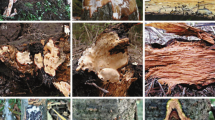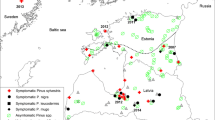Abstract
Norway spruce trees in the subalpine forests of the European Alps are frequently attacked by the needle rust Chrysomyxa rhododendri. The obligate parasite undergoes a complex life cycle with a host shift between rhododendrons (Rhododendron sp.) and Norway spruce [Picea abies (L.) Karsten] and causes a yellowing and defoliation of the current-year needles in summer. Infected trees show several anatomical, morphological and physiological modifications, including a decrease in pigment content and net photosynthesis of infected needles, lower biomass production and reduced radial and height growth. The consequences are diminished timber yield and cripple growth. Because of repeated heavy infections in recent years, forest managers report increasing difficulties in both natural regeneration and afforestation at high elevation sites, where rhododendrons occur. This review gives a summary of the present knowledge about the effects of C. rhododendri infections on Norway spruce, including so far unpublished findings and with particular attention to the phenomena of resistant trees. Implications for subalpine forests and counter strategies are discussed.









Similar content being viewed by others
References
Bassanezi RB, Amorim L, Bergamin Filho A, Berger RD (2002) Gas exchange and emission of chlorophyll fluorescence during the monocycle of rust, angular leaf spot and anthracnose on bean leaves as a function of their trophic characteristics. J Phytopathol 150:37–47
Bauer H, Schwaninger C (2007) Phytopathogens at the alpine timberline. In: Wieser G (ed) Trees at their upper limit. Plant Ecophysiol 5:163–170
Bauer H, Plattner K, Volgger W (2000) Photosynthesis in Norway spruce seedlings infected by the needle rust Chrysomyxa rhododendri. Tree Physiol 20:211–216
Bendel M, Kienast F, Rigling D, Bugmann H (2006) Impact of root-rot pathogens on forest succession in unmanaged Pinus mugo stands in the Central Alps. Can J For Res 36:2666–2674
Bennell AP (1985) Rhododendron rust—taxonomic and horticultural implications. Notes R Bot Gard Edinb 43:25–52
Berndt R (1999) Chrysomyxa rust: morphology and ultrastructure of D-haustoria, uredinia, and telia. Can J Bot 77:1469–1484
Brügger R (1998) Die phänologische entwicklung von buche und fichte. Geogr Inst Univ Bern, Bern
Burger H (1927) Die lebensdauer der fichtennadeln. Schweiz Z Forstwesen 78:372–375
Butin H (1996) Krankheiten der wald- und parkbäume. Georg Thieme Verlag, Stuttgart
Cherubini P, Fontana G, Rigling D, Dobbertin M, Brang P, Innes JL (2002) Tree-life history prior to death: two fungal root pathogens affect tree-ring growth differently. J Ecol 90:839–850
Crane PE (2001) Morphology, taxonomy, and nomenclature of the Chrysomyxa ledi complex and related rust fungi on spruce and ericaceae in North America and Europe. Can J Bot 79:957–982
De Bary A (1879) Aecidium abietinum. Bot Z 37:761–774, 777–789, 801–811, 825–830, 840–847
Dörfelt H (1989) Lexikon der mykologie. Gustav Fischer Verlag, Stuttgart
Dufrénoy J (1932) The unequal susceptibility of spruces towards Chrysomyxa rhododendri. Comptes Rendus Soc Hebdom Soc Biol Filial 109:352–353
Erschbamer B, Wallnöfer S (2007) Vegetation at the upper timberline. In: Wieser G (ed) Trees at their upper limit. Plant Ecophysiol 5:163–170
Gams H (1970) Die erforschung der floren- und vegetationsgeschichte der ötztaler alpen. Mittl Ostalp- din Ges f Vegetkde 11:55–62
Gäumann E (1946) Pflanzliche infektionslehre. Verlag Birkhäuser, Berlin
Gäumann E (1959) Die Rostpilze mitteleuropas. beitr. Kryptogamenflora d. Schweiz 12, Verlag Büchler, Bern
Gäumann E (1964) Die pilze. Verlag Birkhäuser, Basel und Stuttgart
Grill D, Polz I (1983) The influence of Chrysomyxa abietis on chlorophyll and chlorophyll degradation in spruce needles. Phyton (Austria) 23:253–261
Grill D, Welt R, Esterbauer H (1978) Investigations on the ascorbic acid system in spruce needles infected with Chrysomyxa abietis. Z Pflanzenkrankh Pflanzenschutz 85:502–508
Gruber A (2000) Auswirkungen eines befalls mit Chrysomyxa rhododendri auf das höhenwachstum der fichte. University of Innsbruck, Diploma thesis
Heath MC (2000) Hypersensitive response-related death. Plant Mol Biol 44:321–334
Herms DA, Mattson WJ (1992) The dilemma of plants: to grow or defend. Q Rev Biol 67:283–335
Király L, Barna B, Király Z (2007) Plant resistance to pathogen infection: forms and mechanisms of innate and acquired resistance. J Phytopathol 155:385–396
Kohne A (1999) Untersuchung möglicher schutzmechanismen bei Picea abies gegen den befall von Chrysomyxa rhododendri. University of Innsbruck, Diploma thesis
Körner C (2012) Alpine treelines. Functional ecology of the global high elevation tree limits. Springer, Basel
Krehan H (1991) Chrysomyxa fichtennadelrost im zillertal. Forstschutz aktuell 8, forstliche bundesversuchsanstalt wien, Institut für Forstschutz
Kriss M (2001) Dendroökologische untersuchung an Chrysomyxa rhododendri-infizierten fichten (Picea abies)—auswirkungen auf dickenwachstum und holzanatomie. University of Innsbruck, Diploma thesis
Livne A (1964) Photosynthesis in healthy and rust-affected plants. Plant Physiol 39:614–621
Lueth C, Tasser E, Niedrist G, Dalla Via J, Tappeiner U (2011) Plant communities of mountain grasslands in a broad cross-section of the Eastern Alps. Flora 206:433–443
Maier W, Begerow D, Weiß M, Oberwinkler F (2003) Phylogeny of the rust fungi: an approach using nuclear large subunit ribosomal DNA sequences. Can J Bot 81:12–23
Mayr S, Siller C, Kriss M, Oberhuber W, Bauer H (2001) Photosynthesis in rust-infected adult Norway spruce in the field. New Phytol 151:683–689
Mayr S, Schwienbacher F, Bauer H (2003) Winter at the alpine timberline. why does embolism occur in Norway spruce but not in stone pine? Plant Physiol 131:780–792
Mayr S, Schwienbacher F, Beikircher B, Dämon B (2010) Damage in needle tissues after infection with Chrysomyxa rhododendri increases cuticular conductance of Picea abies in winter. Protoplasma 243:137–143
McGrath MT, Pennypacker SP (1990) Alteration of physiological processes in wheat flag leaves caused by stem rust and leaf rust. Phytopathol 80:677–686
Mitchell DT (1979) CO2 exchange by infected first leaf tissues susceptible to wheat stem rust. Trans Br Mycol Soc 72:63–68
Nierhaus-Wunderwald D (2000) Rostpilze an fichten. Merkblatt für die Praxis 32, Eidg. Forsch.-Anst. WSL, Birmensdorf
Oberbacher U (2002) Photosynthetischer elektronentransport und chlorophyll a fluoreszenz in Chrysomyxa rhododendri-infizierten nadeln einer adulten fichte. University of Innsbruck, Diploma thesis
Oberhuber W, Thomaser G, Mayr S, Bauer H (1999) Radial growth of Norway spruce infected by Chrysomyxa rhododenri. Phyton (Horn, Austria) 39:147–154
Oechslin M (1933) Die Chrysomyxa rhododendri. In: Oechslin (ed) Berichte der naturforschenden gesellschaft uri, III. Heft 1932–1933. Naturforschende Gesellschaft Uri, Altdorf
Pfeifhofer (1989) On the pigment content of Norway spruce needles infected with Chrysomyxa rhododendri, and the carotenoids of the fungus aeciospores. Eur J For Pathol 19:363–369
Pickenpack L (2012) Fichtenstecklinge—antworten auf die herausforderung klimawandel. Forstztg spezial 03:1–2
Plattner K (1998) Photosynthese und wachstum Chrysomyxa-infizierter jungfichten. University of Innsbruck, Diploma thesis
Plattner K, Volgger W, Oberhuber W, Mayr S, Bauer H (1999) Dry mass production in seedlings of Norway spruce infected by the needle rust Chrysomyxa rhododendri. Eur J For Pathol 29:365–370
Prell HH, Day PR (2001) Plant-fungal pathogen interaction. A classical and molecular view. Springer, Berlin
Rottensteiner S (2002) Die etablierung früh- und spättreibender jungfichten in gebieten mit starker gefährdung durch den fichtennadelblasenrost. University of Innsbruck, Diploma thesis
Schmidt-Vogt H (1989) Die fichte. Band 2 Krankheiten, Schäden, Fichtensterben. Paul Parey, Hamburg
Siller C (1999) Auswirkungen eines Chrysomyxa-Befalls auf die photosynthese erwachsener fichten. University of Innsbruck, Diploma thesis
Stakman EC (1915) Relation between Puccina graminis and plants highly resistant to its attack. J Agric Res 4:193–199
Staples RC (2000) Research on the rust fungi during the twentieth century. Annu Rev Phytopathol 38:49–69
Tasser E, Tappeiner U (2002) Impact of land use changes on mountain vegetation. Appl Veg Sci 5:173–184
Tasser E, Prock S, Mulser J (1999) The impact of land use on vegetation along the Eastern Alpine Transect. In: Cernusca A (ed) Land-use changes in European mountain ecosystems: ECOMONT—concepts and results. Blackwell Wiss. Verlag, Berlin
Volgger W (1997) Auswirkungen einer infektion mit Chrysomyxa rhododendri auf photosynthese und wachstum der fichte. University of Innsbruck, Diploma thesis
Weißenbacher L, Herz H, Schüler S, Zwerger P (2007) Fichtenstecklinge—eine alternative für hochlagenaufforstungen. Forstztg 06:36–38
West JS, Townsend JA, Stevens M, Fitt BDL (2012) Comparative biology of different plant pathogens to estimate effects of climate change on crop diseases in Europe. Eur J Plant Pathol 133:315–331
Wolf FT (1956) Changes in chlorophyll a and b in autumn leaves. Am J Bot 43:714–718
Yarwood CE (1967) Response to parasites. Annu Rev Plant Physiol 18:419–438
Acknowledgments
This research was financed by the alpS-project Adapt AF-C. Thanks go to the project partners Landesforstgärten, Landesforstdirektion and Waldpflegeverein Tirol for the kind support, to the Autonome Provinz Bozen and the Federal Research Centre for forests Austria for providing data, as well as to the anonymous reviewers for helpful comments on the manuscript.
Author information
Authors and Affiliations
Corresponding author
Additional information
Communicated by R. Matyssek.
Rights and permissions
About this article
Cite this article
Ganthaler, A., Bauer, H., Gruber, A. et al. Effects of the needle bladder rust (Chrysomyxa rhododendri) on Norway spruce: implications for subalpine forests. Eur J Forest Res 133, 201–211 (2014). https://doi.org/10.1007/s10342-013-0770-6
Received:
Revised:
Accepted:
Published:
Issue Date:
DOI: https://doi.org/10.1007/s10342-013-0770-6




